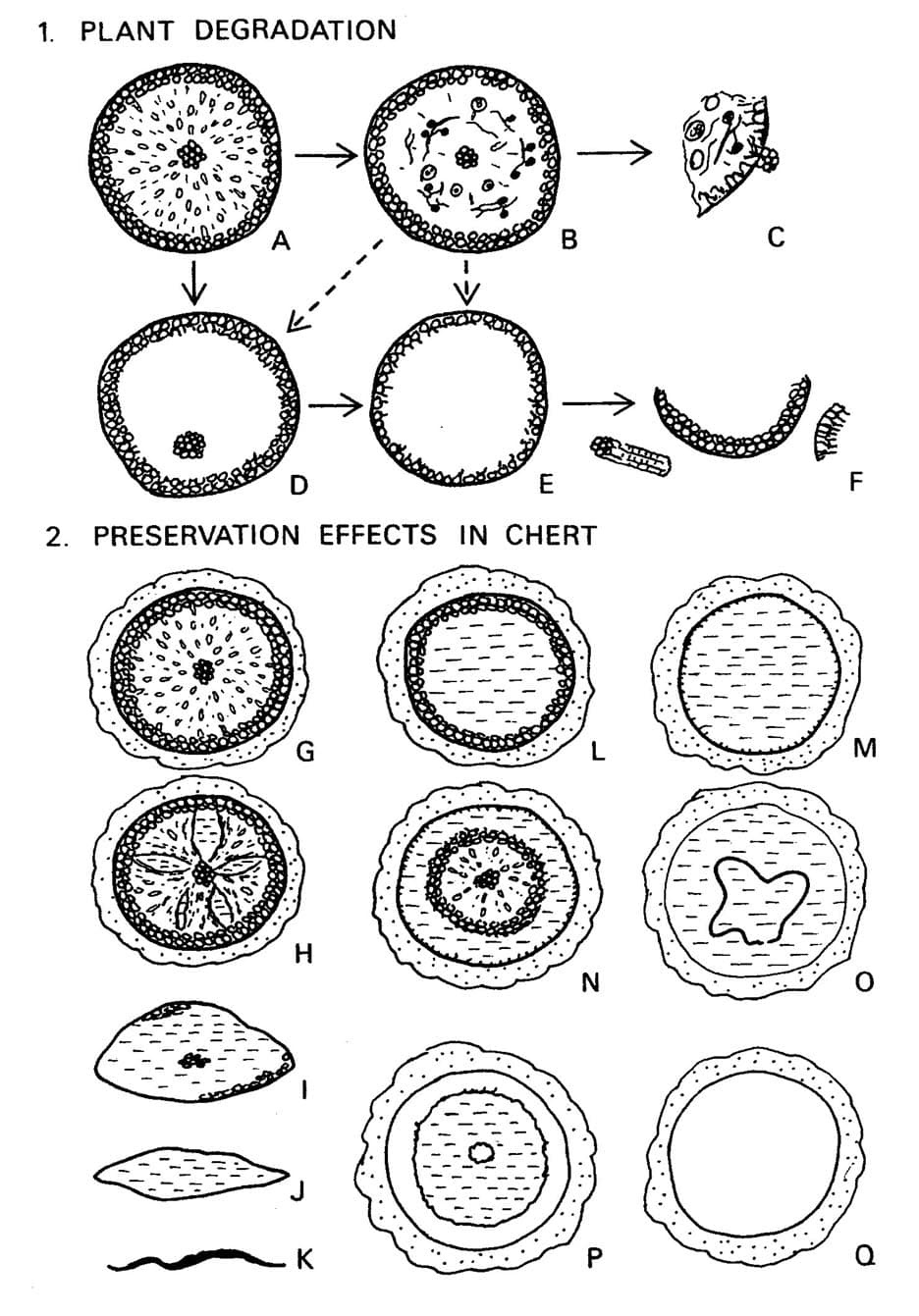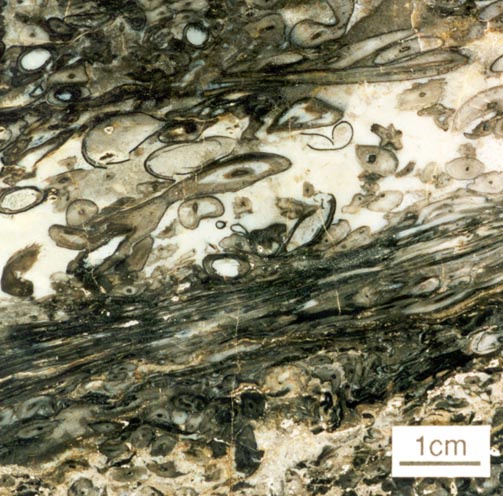Taphonomy is the study of the various overlapping, consecutive processes which can affect organic remains prior to burial and their inclusion in the fossil record. These processes include the following:
- Necrolysis - decomposition of soft tissues and possible break-up of parts.
- Biostratinomy - processes affecting the organic remains during deposition and before final burial (such as dissociation, scavenging, bioerosion, transport, breakage).
- Diagenesis - processes affecting organic remains and sediments after burial (such as mechanical compaction, chemical dissolution, mineralogical transformations, cementation).
- Metamorphism - the mineralogical and structural alteration of rocks by increased heat and pressure, typically during deep burial and tectonism. This may result in the tectonic distortion of fossils, but most often metamorphism completely obliterates any fossil remains.
As we have seen in earlier sections of this resource the Rhynie chert is a unique deposit because it preserves in remarkable detail an Early Devonian terrestrial and freshwater community of plants and animals. The plants and animals are sometimes preserved in such exquisite detail that their internal anatomy can be described. This 'mother lode' of exceptionally preserved organisms means that the Rhynie chert may be referred to as a konservat lagerstätte. This is a term used to describe those few geological sites where, for a combination of chemical and physical environmental conditions at the time of deposition and burial, organisms with delicate non-mineralised tissues not usually seen in the fossil record are well preserved and have undergone very little decay. Other examples of konservat lagerstätte include insects in amber and Siberian mammoths preserved in ice.
In the case of the Rhynie chert the method of mineralisation and its timing with respect to the death and decay of the plants and animals is the key to their remarkable preservation. Within the Rhynie chert the organisms have been preserved relatively early, very often at or soon after death by their inundation by hot spring fluids supersaturated with respect to dissolved silica. The silica coming rapidly out of solution as a result of the gradual temperature drop and evaporation of the flowing water, encrusted and permineralised the organic matter at a cellular level, and continuing silica precipitation both at the surface and during early burial ensured the inclusion of the Rhynie biota in the rock record.
Note: The means of silicification of organic material and soft tissues and the conversion of sinter to chert is complex, but will be summarised in the following section on silicification and the conversion of sinter to chert.
Preservation of the Biota
The preservation of the flora (plants) and fauna (animals) is variable depending mainly on two things; their condition at the time of fossilisation (for example the amount of cellular decay) and secondly on the degree and timing of silica permineralisation and petrifaction. Therefore, there is a whole range of preservation types, ranging from the exquisitely preserved 3D internal anatomy of those organisms that were completely silicified at or soon after death, to organisms preserved as compressed, unidentifiable, coalified laminae that were silicified after decay and burial. The diagram below right, gives an idea of the effects of degradation prior to silicification and the effects of silicification itself, specifically with respect to the preservation of the flora (Trewin 1996).

(1) Plant degradation: (A) Unaltered plant axis. (B) Decay of plant axis by fungal and bacterial pathogens. (C) Fragments of of infected plants. (D) Decay of less resistant cells resulting in xylem strand falling to base of hollow 'straw'. (E) Hollow straw. (F) Fragments of xylem strand and outer cuticle.
(2) Preservation / silicification effects: (G-K) Range from perfect 3D cellular preservation (G) to coalified compression (K) with intermediate stages. (H) Shrinkage of plant tissue producing radial chert-filled gashes. (I) Partial compaction with loss of cellular structure. (J) Lens of chert with no internal structure. (L) Permeation and silicification only of outer ring of cells, decay of inner tissue creates void later filled with chert (cf. E). (M) Only the outer cuticle is preserved. (N) Plant tissue shrunk away from cuticle and resulting annulus later filled with chert. (O) Cuticle shrunk away from enclosing chert, void later filled with chert. (P) Chert filling void in straw followed by loss of xylem strand and outer ring of cells resulting in pore space. (Q) Only a single void to show the previous presence of a plant axis (after Trewin 1996).
With regards to the preservation of the plants, their orientation is also variable, ranging from autochthonous upright stems with horizontal attached rhizomes, evidently in growth position; to collapsed and decayed, prostrate stems apparently representing plant litter. Allochthonous or transported plant material is also often recognisable (see also the section on the Rhynie Chert Flora).

With regards to the fauna, the preservation is locally so exquisite that entrapment and silicification must have also happened at or very soon after death, since in a few cases where the whole bodies of arthropods have been found (i.e. as opposed to moulted exoskeletons) gut contents have been found preserved, and even delicate features such as lungs and tracheal elements are perfectly silicified (see the section on the Rhynie Chert Fauna). Many of the animals, particularly the crustaceans and even their exuviae (moults) appear to have remained cohesive and articulated during preservation with little or no signs of prior desiccation suggesting silicification occurred whilst they were still in an aquatic environment.
Therefore, not only can information be gleaned about the internal anatomy of the plants and animals, but also about their preservation, distribution, growth habit, association and interaction with other Rhynie flora and fauna.
For a general overview of taphonomy refer to Goldring (1991), and for a more detailed treatment refer to Allison & Briggs (1991).
